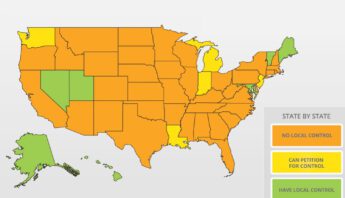Pets run on lawns laced with chemicals, eat bait put out for snails, ants or mice, and are subjected to topical flea treatments that are not safe for either them or their families — particularly children, who are especially vulnerable to pesticide harms and may be exposed when petting or hugging an animal.
An entertaining yet cautionary video, The Truth About Cats, Dogs and Lawn Chemicals presents the dangers posed by lawn and garden pesticides and provides information on pesticide-free alternatives. The filmmakers provide a companion community action tookit if you’d like to inform your pet-loving friends and neighbors as well.
<>
Non-toxic flea treatments
Fleas can cause animals a great deal of discomfort and stress — and chemical treatments, from systemic products like Frontline or Advantage to flea collars, can result in increased health risks for pets and their humans.
Safer approaches to flea control include washing throw rugs and bedding weekly, using flea combs on your pets, vacuuming and applying nematodes to soil where your pets spend time. For more details on how to keep your pets and household flea-free, take a look at the following resources:
- Managing Fleas Without Pesticides from Northwest Center for Alternatives to Pesticides
- How To Control Fleas Without Chemicals from Natural Resources Defense Council
- Keeping Fleas Off Your Pets and Out of Your Yard from the Central Contra Costa Sanitary District
- Fleas from University of California IPM Online
Safer rodent control
As we all know, dogs and cats (especially cats) eat rodents. And if a mouse or rat has ingested a rodenticide, our pets will be eating that poison too — sometimes with devastating consequences. The U.S. EPA states that more than 100 pet deaths are reported each year from exposure to rodenticides, and many more go unreported.
TIP: If you suspect that your pet has been exposed to rodenticides, take immediate action and contact your veterinarian or Animal Poison Control Center at (888) 426-4435.
Birds of prey are also susceptible to making a deadly meal of a poisoned rat or mouse. And other animals sometimes find rat poison and mistake it for food. In short, rodenticides pose a threat to household pets and non-target wildlife.
Safeguarding your home from rats, mice and other rodents doesn’t require the use of potentially hazardous poisons. There are three guiding principles for maintaining a rodent free home:
- Prevent! First, seal entry points to prevent rodents from entering your home or business. And remove rodent attractions such as food or shelter by ensuring that food is securely stored and that surroundings are clean.
- Identify! Look for signs of rats and mice such as rodent droppings around food, in kitchen corners, inside cabinets or under sinks. Also, look for nesting material such as shredded paper or fabric.
- Treat! Remove rodents by using snap or electronic traps. Be cautious with live traps as rodents might urinate, which increases the risk of spreading disease. In addition, some states prohibit releasing rodents into the wild.
Some of the worst rodenticides have been taken off the market, thanks in part to the efforts of PAN and our partners. But those available for sale still pose a threat to pets and wildlife.
Safe, effective and affordable solutions can help you rodent-proof your home while ensuring the health of your pets. Take a look at these resources to learn more:
- Rodent control solutions & alternatives from the Safer Rodent Control Coalition
- Rodenticides details and alternatives from Beyond Pesticides
Pesticide-free yard & garden
Every year, U.S. homeowners apply 80 million tons of synthetic fertilizers and pesticides to their lawns. This “cosmetic” use provides pesticide corporations their fastest sales growth. It also presents growing environmental and health dangers, especially for children and pets.
When pets walk through chemically-treated areas, they absorb pesticides through their mouth, nose and eyes — and powdered pesticides can stick to their fur. Dogs often absorb chemical residues by chewing or eating treated plant material, and cats tend to ingest a higher dosage because of their grooming habits.
Dig into these resources from Beyond Pesticides for information on how to maintain your yard and garden so they’re safe for your pets.







